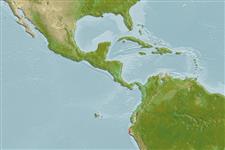>
Ophidiiformes (Cusk eels) >
Ophidiidae (Cusk-eels) > Ophidiinae
Etymology: Lepophidium: Latin, lepus, leporis = rabbit + Greek, ophis = serpent (Ref. 45335).
Environment: milieu / climate zone / depth range / distribution range
Ecologia
marino demersale; distribuzione batimetrica 118 - 320 m (Ref. 91765). Tropical; 3°S - 7°S, 83°W - 80°W (Ref. 91765)
Distribuzione
Stati | Aree FAO | Ecosystems | Presenze | Point map | Introduzioni | Faunafri
Southeast Pacific: known only from the ocean off northern Peru (Piura Province);
Size / Peso / Age
Maturity: Lm ? range ? - ? cm
Max length : 19.6 cm SL maschio/sesso non determinato; (Ref. 91765)
Short description
Morfologia | Morfometria
Raggi dorsali molli (totale): 133-141; Raggi anali molli: 112 - 121; Vertebre: 74 - 77. This species have the following characteristics: pyloric caeca usually 7-8 in 1 or 2 whorls, typically 6+2; usually 3 rudimentary gill rakers on the upper arm of the first arch, 4-5 developed rakers on lower arm, usually 2-3 rudimentary rakers anteriorly on the lower arm; total gill rakers 9-13; dorsal-fin origin between neural spines 3-4; head and body uniformly dusky; pectoral fins clear; dorsal and anal fins clear with a dark edge, most developed in the anal fin; posterior part of the roof of the mouth, upper pharyngeal region, and gill bars are blackish; esophagus, caeca, and anterior part of the intestine are blackish (Ref. 91765).
Life cycle and mating behavior
Maturità | Riproduzione | Deposizione | Uova | Fecundity | Larve
Robins, C.R., R.H. Robins and M.E. Brown, 2012. A revision of Lepophidium (Teleoastei, Ophidiidae), with descriptions of eight new species. Bulletin of the Florida Museum of Natural History 52(1):1-94. (Ref. 91765)
IUCN Red List Status (Ref. 130435)
Threat to humans
Harmless
Human uses
Informazioni ulteriori
StatiAree FAOEcosystemsPresenzeIntroduzioniStocksEcologiaDietaPredeConsumo di ciboRazione
Nomi ComuniSinonimiMetabolismoPredatoriEcotossicologiaRiproduzioneMaturitàDeposizioneSpawning aggregationFecundityUovaEgg development
Age/SizeAccrescimentoLength-weightLength-lengthLength-frequenciesMorfometriaMorfologiaLarveDinamica popolazioni larvaliReclutamentoAbbondanzaBRUVS
BibliografiaAcquacolturaProfilo di acquacolturaVarietàGeneticaElectrophoresesEreditarietàMalattieElaborazioneNutrientsMass conversion
CollaboratoriImmaginiStamps, Coins Misc.SuoniCiguateraVelocitàModalità di nuotoArea branchialeOtolithsCervelliVista
Strumenti
Special reports
Download XML
Fonti Internet
Estimates based on models
Preferred temperature (Ref.
123201): 5.6 - 14, mean 8.4 °C (based on 4 cells).
Phylogenetic diversity index (Ref.
82804): PD
50 = 0.5000 [Uniqueness, from 0.5 = low to 2.0 = high].
Bayesian length-weight: a=0.00102 (0.00046 - 0.00225), b=3.06 (2.88 - 3.24), in cm total length, based on all LWR estimates for this body shape (Ref.
93245).
Trophic level (Ref.
69278): 3.6 ±0.7 se; based on size and trophs of closest relatives
Resilienza (Ref.
120179): Alto, tempo minimo di raddoppiamento della popolazione meno di 15 mesi (Preliminary K or Fecundity.).
Fishing Vulnerability (Ref.
59153): Low vulnerability (14 of 100).
